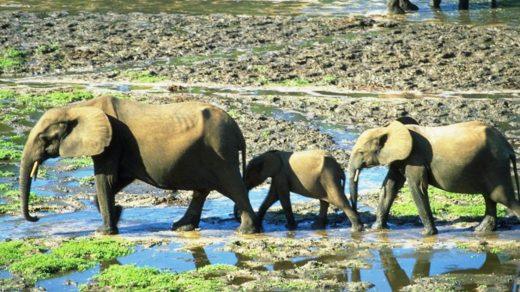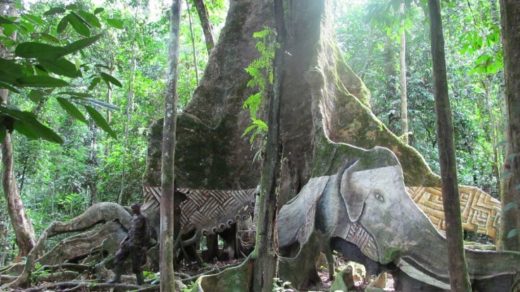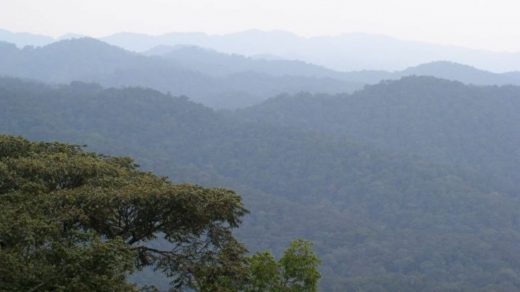Located in north-western Rwanda, Volcanoes National Park is aptly named because it is home to five of the eight volcanoes in the Virunga Mountains.
This park is also famous for its mountain gorillas, and was the base for the primatologist Dian Fossey who studied mountain gorillas in Rwanda from 1966 to her murder in 1985. Her work strongly boosted international interest in protecting the mountain gorillas, and the autobiography about her life with the gorillas served as the foundation for the 1988 film “Gorillas in the Mist”. After her death, she was buried at the gorilla burial ground within the park.
Another notable conservationist associated with this park is the Rwandan environmentalist Eugène Rutagarama, renowned for his efforts to protect the mountain gorillas in this park during the Rwandan Civil War as well as during later armed conflicts originating in Democratic Republic of Congo (DRC). In 2001, Rutagarama was awarded the Goldman Environmental Prize, also known as the “Green Nobel”.
Where is Volcanoes National Park?
Coordinates: 01°28′03″S 29°29′33″E
The Volcanoes National Park is found in north-western Rwanda, and borders the Virunga National Park in the DRC and the Mgahinga Gorilla National Park in Uganda.
How large is Volcanoes National Park?
It covers 160 square kilometres.
Names
English name: Volcanoes National Park
Kinyarwanda name: Pariki y’Igihugu y’Ibirunga
French name: Parc National des Volcans
History
Establishment
In 1925, a small area bounded by Karisimbi, Bisoke and Mikeno was gazetted to provide a protected space for gorillas where they would not be killed by poachers. In 1929, the borders were extended into Rwanda and into Belgian Congo, to form the Albert National Park – a large protected area covering 8,090 square kilometres. This park was run by the Belgian colonial authorities.
Diminishing size
In 1958, 700 hectares (7 sq km) of the park were cleared for a human settlement.
In 1969-1973, 1,050 hectares (10.5 sq km) of the park were cleared to grow Pyrethrum.
The Rwandan Civil War
The Volcanoes National Park became a conflict zone during the Rwanda Civil War. In 1992, the park headquarters was attacked. The research centre was abandoned and all tourist activities came to a halt.
Research and tourism resumed again in 1999.
Environment
The park is home to five tall volcanoes, and many different habiat types are represented along their slopes. The five volcanoes are Karisimbi, Bisoke, Muhabura, Gahinga and Sabyinyo.
- Some lower montane forest still exist here, but this habitat type used to cover a much larger area before deforestation accured to give room for agriculture at low elevations.
- At an elevation of 2400 – 2500 metres above sea level, the dominating habitat type is Neobutonia forest.
- Bamboo forest dominated by Arundinaria alpina is found from circa 2500 to 3200 metres towards the north and east, and it covers roughly 30% of the total park area. On the more humid slopes facing the south and west, we instead find Hagenia-Hypericum forests from circa 2600 to 3600 metres; a habitat type covering another 30% of the park. A dominating species here is Hagenia abyssinica.
- If we move up even higher, we reach the 3500 – 4200 metre altitude range where the environment is characterized by Lobelia wollastonii, L. lanurensis, and Senecio erici-rosenii. Roughly one-quarter of the park consists of this habitat type.
- At circa 4300 to 4500 metres, we are above the tree line and in a grassland environment.
It should be noted that this national park also includes small lakes and wetland environments, including marshes and swamps, but the total area of those environments is comparatively small. There is also some meadows and secondary thicket.
Examples of animals living in the park
Primates: Both mountain gorillas (Gorilla beringei beringei) and golden monkeys (Cercopithecus mitis kandti) live here.
Canines: Spotted hyena (Crocuta crocuta)
Grazers: Black-fronted duikers (Cephalophus niger), buffalo (Syncerus caffer), bushbuck (Tragelaphus scriptus)
Occasional sightings of elephants have been reported, but they are very rare.
The Karisoke Research Center
The Karisoke Research Center was established between Mount Karisimbi and Mount Bisoke in the Volcanoes National Park in 1967 by primatologist Dian Fossey. It is still active and focused on montain gorilla research and protection, operated by the Dian Fossey Gorilla Fund International.
In 2012, the research centre moved from its original spot to a more modern facility within the same region.


